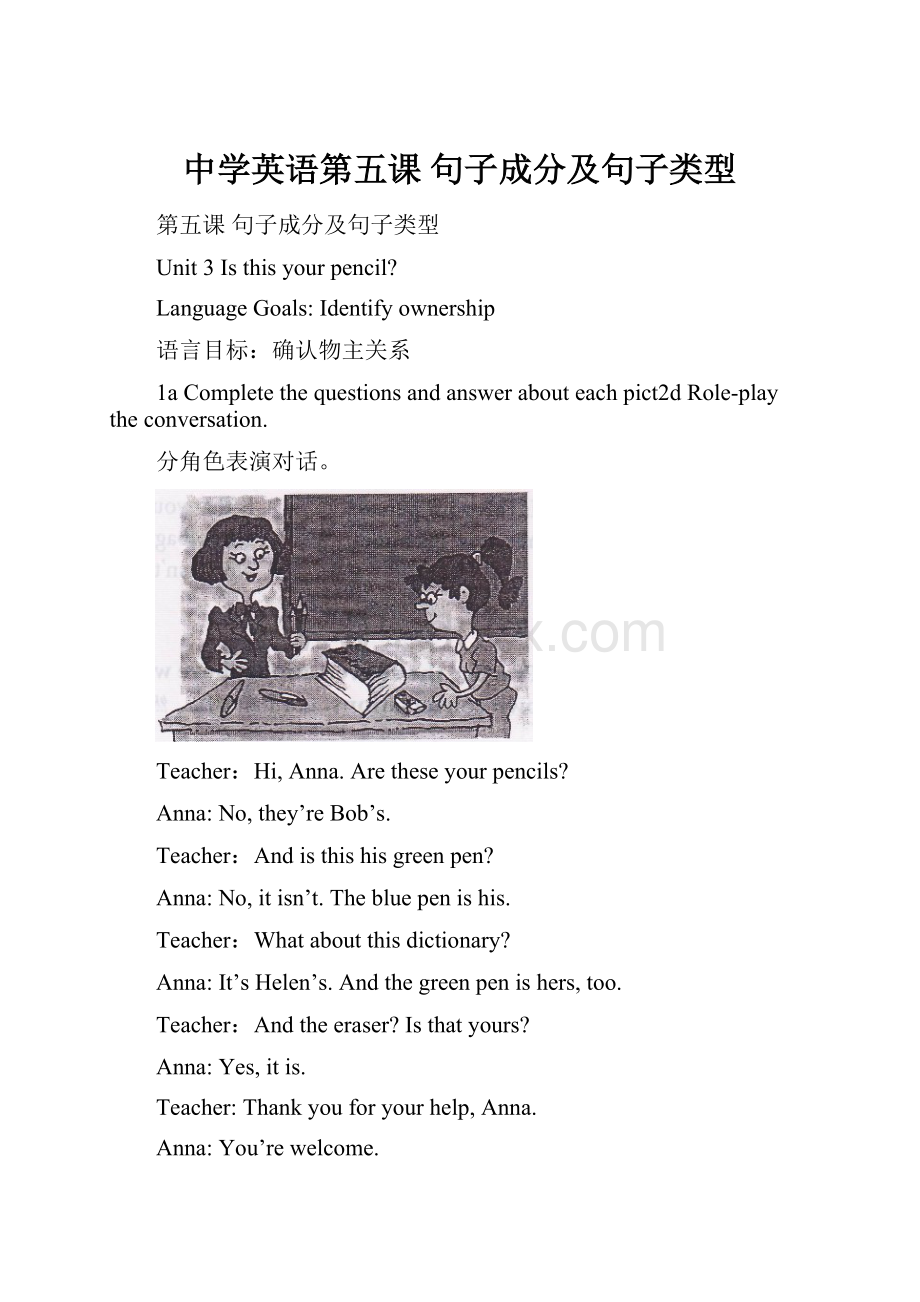 中学英语第五课 句子成分及句子类型.docx
中学英语第五课 句子成分及句子类型.docx
- 文档编号:9856331
- 上传时间:2023-02-07
- 格式:DOCX
- 页数:27
- 大小:114.27KB
中学英语第五课 句子成分及句子类型.docx
《中学英语第五课 句子成分及句子类型.docx》由会员分享,可在线阅读,更多相关《中学英语第五课 句子成分及句子类型.docx(27页珍藏版)》请在冰豆网上搜索。

中学英语第五课句子成分及句子类型
第五课句子成分及句子类型
Unit3Isthisyourpencil?
LanguageGoals:
Identifyownership
语言目标:
确认物主关系
1aCompletethequestionsandanswerabouteachpict2dRole-playtheconversation.
分角色表演对话。
Teacher:
Hi,Anna.Aretheseyourpencils?
Anna:
No,they’reBob’s.
Teacher:
Andisthishisgreenpen?
Anna:
No,itisn’t.Thebluepenishis.
Teacher:
Whataboutthisdictionary?
Anna:
It’sHelen’s.Andthegreenpenishers,too.
Teacher:
Andtheeraser?
Isthatyours?
Anna:
Yes,itis.
Teacher:
Thankyouforyourhelp,Anna.
Anna:
You’rewelcome.
2a根据图片补全问句和答语。
Is_________yourbook?
Yes,itis.
No,it_________
Are________mypencils?
Yes,________are.
No,theyaren’t.
Is_________hisruler?
Yes,it__________.
No,itisn’t.
Are_________herpens?
Yes,theyare.
No,they_________.
3aCompletethenoticeswiththewordsorphonenumberinthebox.
选择正确的单词或号码补全信息。
nameyoursfound284-5486lostcall
_____________:
Mynotebook
My__________isDavid.
Please__________meat679-8871.
____________:
Asetofkeys
Arethese___________?
CallJennyat_____________.
1b语法知识:
句子成分及句子类型:
Isthisyourpencil?
Yes,itis.It’smine./No,itisn’t.It’shers.
Isthishisgreenpen?
Yes,itis./No,itisn’t.Thebluepenishis.
Isthatyourschoolbag?
Yes,itis./No,itisn’t.It’shis.
Aretheseyourbooks?
Yes,theyare./No,theyaren’t.They’rehers.
Arethoseherkeys?
Yes,theyare./No,theyaren’t.They’remine.
It’s=itisisn’t=isnotaren’t=arenot
2b句子成分(MembersofaSentence)
什么叫句子成分呢?
句子的组成成分叫句子成分。
在句子中,词与词之间有一定的组合关系,按照不同的关系,可以把句子分为不同的组成成分。
句子成分由词或词组充当。
现代汉语里一般的句子成分有六种,即主语、谓语、宾语、定语、状语和补语。
英语的基本成分有七种:
主语(subject)、谓语(predicate)、表语(predicative)、宾语(object)、定语(attribute)、状语(adverbial) 和补语(complement)。
英语句子的基本结构可以归纳成五种基本句型及其扩大、组合、省略或倒装。
掌握这五种基本句型,是掌握各种英语句子结构的基础。
英语五种基本句型列式如下:
一:
SV(主+谓)
二:
SVP (主+系+表)
三:
SVO(主+谓+宾)
四:
SVoO(主+谓+间宾+直宾)
五:
SVOC(主+谓+宾+宾补)
基本句型一:
SV(主+谓)
主语:
可以作主语的成分有名词(如boy),主格代词(如you),动词不定式,动名词等。
主语一般在句首。
注意名词单数形式常和冠词不分家!
谓语:
谓语由动词构成,是英语时态、语态变化的主角,一般在主语之后。
不及物动词(vi.)没有宾语,形成主谓结构,如:
Wecome.
此句型的句子有一个共同特点,即句子的谓语动词都能表达完整的意思。
这类动词叫做不及物动词,后面可以跟副词、介词短语、状语从句等。
S│V(不及物动词)
1.Thesun│wasshining. 太阳在照耀着。
2.Themoon│rose. 月亮升起了。
3.Theuniverse│remains. 宇宙长存。
4.Weall│breathe,eat,anddrink. 我们大家都呼吸、吃和喝。
5.Who│cares?
管它呢?
6.Whathesaid│doesnotmatter. 他所讲的没有什么关系。
7.They│talkedforhalfanhour. 他们谈了半个小时。
8.Thepen│writessmoothly 这支笔书写流利。
基本句型二:
SVP(主+系+表)
此句型的句子有一个共同的特点:
句子谓语动词都不能表达一个完整的意思,必须加上一个表明主语身份或状态的表语构成复合谓语,才能表达完整的意思。
这类动词叫做连系动词。
系动词分两类:
be,look,keep,seem等属一类,表示情况;get,grow,become,turn等属另一类,表示变化。
be本身没有什么意义,只起连系主语和表语的作用。
其它系动词仍保持其部分词义。
感官动词多可用作联系动词:
lookwell/面色好,soundnice/听起来不错,feelgood/感觉好,smellbad/难闻
S│V(是系动词)│P
1.This│is│anEnglish-Chinesedictionary. 这是本英汉辞典。
2.Thedinner│smells│good. 午餐的气味很好。
3.He│fell│inlove. 他堕入了情网。
4.Everything│looks│different. 一切看来都不同了。
5.He│isgrowing│tallandstrong. 他长得又高又壮
6.Thetrouble│is│thattheyareshortofmoney. 麻烦的是他们缺少钱。
7.Ourwell│hasgone│dry. 我们井干枯了。
8.Hisface│turned│red. 他的脸红了。
Therebe结构:
Therebe表示‘存在有’。
这里的there没有实际意义,不可与副词‘there那里’混淆。
此结构后跟名词,表示‘(存在)有某事物’
试比较:
Thereisaboythere.(那儿有一个男孩。
)/前一个there无实意,后一个there为副词‘那里’。
基本句型三:
SVO(主+谓+宾)
此句型句子的共同特点是:
谓语动词都具有实义,都是主语产生的动作,但不能表达完整的意思,必须跟有一个宾语,即动作的承受者,才能使意思完整。
这类动词叫做及物动词。
宾语位于及物动词之后,一般同主语构成一样,不同的是构成宾语的代词必须是‘代词宾格’,如:
me,him,them等
S│V(及物动词)│O
1.Who│knows│theanswer?
谁知道答案?
2.She│smiled│herthanks.她微笑表示感谢。
3.He│hasrefused│tohelpthem.他拒绝帮他们。
4.He│enjoys│reading.他喜欢看书。
5.They│ate│whatwasleftover.他们吃了剩饭。
6.He│said│"Goodmorning."他说:
"早上好!
"
7.I│want│tohaveacupoftea.我想喝杯茶。
8.He│admits│thathewasmistaken.他承认犯了错误。
基本句型四:
SVoO(主+谓+间宾+直宾)
有些及物动词可以有两个宾语,如:
give给,pass递,bring带,show显示。
这两个宾语通常一个指人,为间接宾语;一个指物,为直接宾语。
间接宾语一般位于直接宾语之前。
一般的顺序为:
动词+间接宾语+直接宾语。
如:
Givemeacupoftea,please.
强调间接宾语顺序为:
动词+直接宾语+介词+间接宾语。
如:
ShowthishousetoMr.Smith.
若直接宾语为人称代词:
动词+代词直接宾语+介词+间接宾语。
如:
Bringittome,please.
S│V(及物)│o(多指人)│O(多指物)
1.She│ordered│herself│anewdress.她给自己定了一套新衣裳。
2.She│cooked│herhusband│adeliciousmeal.她给丈夫煮了一顿美餐。
3.He│brought│you│adictionary.他给你带来了一本字典。
4.He│denies│her│nothing.他对她什么都不拒绝。
5.I│showed│him│mypictures.我给他看我的照片
6.I│gave│mycar│awash.我洗了我的汽车。
7.I│told│him│thatthebuswaslate.我告诉他汽车晚点了。
8.He│showed│me│howtorunthemachine.他教我开机器。
基本句型五:
SVOC(主+谓+宾+宾补)
此句型的句子的共同特点是:
动词虽然是及物动词,但是只跟一个宾语还不能表达完整的意思,必须加上一个补充成分来补足宾语,才能使意思完整。
宾语补足语:
位于宾语之后对宾语作出说明的成分。
宾语与其补足语有逻辑上的主谓关系,它们一起构成复合宾语。
名词/代词宾格+名词
Thewarmadehimasoldier./战争使他成为一名战士.
名词/代词宾格+形容词
Newmethodsmakethejobeasy./新方法使这项工作变得轻松.
名词/代词宾格+介词短语
Ioftenfindhimatwork./我经常发现他在工作.
名词/代词宾格+动词不定式
Theteacheraskthestudentstoclosethewindows./老师让学生们关上窗户.
名词/代词宾格+分词
Isawacatrunningacrosstheroad./我看见一只猫跑过了马路.
S│V(及物)│O(宾语)│C(宾补)
1.They│appointed│him│manager.他们任命他当经理。
2.They│painted│thedoor│green.他们把门漆成绿色
3.This│set│them│thinking.这使得他们要细想一想。
4.They│found│thehouse│deserted.他们发现那房子无人居住。
5.What│makes│him│thinkso?
他怎么会这样想?
6.We│saw│him│out.我们送他出去
7.He│asked│me│tocomebacksoon.他要我早点回来。
8.I│saw│them│gettingonthebus.我看见他们上了那辆公共汽车。
句子成分练习题
A
1.___sixyearssinceIbegantostudyEnglish.
A.ItisB.IhavebeenC.ThereareD.Itwas
2.___intheroomatthattime.
A.NobodywasB.SomeonewereC.WhoisD.Heare
3.IT'Sverynoisyoutside.___isgoingon?
A.WhoB.WhatC.WhichD.Where
4.___inEnglishinclasseverydayisimportant.
A.SpeakB.TalkingC.SayingD.Totell
5.Theremustbe____nearthefactory.
A.abookstoreB.bookstoreC.booksstoreD.booksstores
6.Althoughit'sraininghard,___arestillworkinginthefields.
A.buttheyB.andtheyC.theyD.sincethey
B
1.Thedoctoraswellasthenurses___greatconcernforthepatients.
A.showB.showsC.haveshownD.areshowing
2.Yoursonmustbeacleverboy,___he?
A.isB.isn'tC.mustD.mustn't
3.Thecomputercenter,___lastyear,isverypopularamongstudentsinthisschool.
A.openB.openingC.openedD.beingopened
4.I___gototheshoptoday,forthereisalotoffoodathome.
A.mustn'tB.hadtoC.can'tD.needn't
5.Don't___excited.
A.getB.isC.seemD.look
6.Thisroom___everymorning.
A.iscleaningB.iscleanedC.cleansD.cleaning
C
1.Gladtomeetyou!
___isyourfullname?
A.WhatB.WhereC.HowD.Who
2.Heis___tolifttheheavybox.
A.tooweakB.weaktooC.enoughweakD.weakenough
3.Thedaysare___warmerandwarmerinspring.
A.gettingB.lookingC.seemingD.going
4.Hisjobis____English.
A.teachB.toteachC.taughtD.teaches
5.Twoballsare___.
A.underthedeskB.inthewallC.tohereD.atdesks
D
1.Weshouldgetready___others.
A.helpingB.tohelpC.helpD.helpwith
2.___interestingworkwearedoing?
A.WhataB.HowC.WhatD.Whatan
3.Iwant___ateacherwhenIgrowup(-fx;fc).
A.tobeB.toC.beD.being
4.-Wouldyouliketogoonapicnicwithmetoday?
-Idon'tthinkso.Tobehonest,Ireallydon'tfeellike___ona
picnic.
A.goingB.togoC.goD.went
5.Doyouknow___?
A.wheredoesheliveB.wherehelives
C.whereheliveD.ifwherehelives
6.Let____doitagain.
A.IB.meC.heD.she
7.Idon'tknow___.
A.howtodoB.whattodoC.wheretodoD.whentodo
E
1.Isawhim___basketballwithJackanhourago.
A.playsB.toplayC.playedD.playo
2.Sorry,we'vekeptyou___foralongtime.
A.waitedB.singC.standD.waiting
3.Theteachertoldus____lateagain.
A.aren'tbeB.don'tbeC.nottobeD.notbe
4.Wefindtheroomvery___.
A.warmB.warmlyC.terriblyD.hardly
F
1.Ifound___difficulttoworktogetherwithhim.
A.itB.itsC.thatD.those
2.Weallknow___ourdutytocleanourclassroomafterschooleveryday.
A.thatB.thisC.whichD.it
3.Hefound___veryinterestingtoplaywiththelittledog.
A.whatB.itC./D.that
G
1.Tomsaidhe___agooddreamyesterdayevening.
A.dreamB.dreamedC.haveD.has
2.Children___ahappylifeinChina.
A.leadB.livingC.hasD.leading
H
1.America,JapanandCanadaare___countries.
A.developingB.developedC.lessdevelopedD.develop
2.-___skirtisthatonthechair?
-Letmesee.Oh,no,it'snotmine.
A.WhoseB.WhatC.Who'sD.Which
3.Doyouhaveanything___?
A.sayingB.to^ayC.saidD.say
4.Look,thereisan___treebythewall.
A.appleB.apple'sC.apples'D.apples
5.Whereis____seat?
A.yoursB.yourC.youD.Yourselves
I
1.Theboxis___heavyforher___carry.
A.very;toB.too;notto
C.too;toD.verytoo;to
2.-___didyoubuythenewbag?
-LastMonday.
A.WhereB.HowC.WhenD.Who
3Youcanseethesesignsinahospital.___canyouseethem?
A.WhereelseB.Whereplaceelse
C.WhereelseplaceD.Elsewhere
4.Theywentout___theiroldfriends.
A.visitB.visitingC.tovisitD.visited
5.Thereisawideriver____ourvillage.
A.outsideB.overC.fromD.below
J
1.Theyoungman,___worksintheoffice.
A.mebrotherB.mybrotherC.mybrothersD.me
2.OurEnglishteacher,___oftenhelpsuswithstudy.
A.MrsWangB.Mrs5WangC.MrsWang's.D.ofhim
3.___,somerailwayworkersarebusyrepairingthetrain.
A.ThemB.HeC.TheyD.Theirs
A.1-6AABBACB.1-6BBCDABC.1-5AAABA
D.1-7BCAABBBE.1-4DDCAF.1-3ADBG.1-2BA
H.1-5BABABI.1-5CCACAJ.1-3BAC
3b句子类型(Typesofsentences)
句子按
- 配套讲稿:
如PPT文件的首页显示word图标,表示该PPT已包含配套word讲稿。双击word图标可打开word文档。
- 特殊限制:
部分文档作品中含有的国旗、国徽等图片,仅作为作品整体效果示例展示,禁止商用。设计者仅对作品中独创性部分享有著作权。
- 关 键 词:
- 中学英语第五课 句子成分及句子类型 中学英语 第五 句子成分 句子 类型
 冰豆网所有资源均是用户自行上传分享,仅供网友学习交流,未经上传用户书面授权,请勿作他用。
冰豆网所有资源均是用户自行上传分享,仅供网友学习交流,未经上传用户书面授权,请勿作他用。


 《JAVA编程基础》课程标准软件16级.docx
《JAVA编程基础》课程标准软件16级.docx
